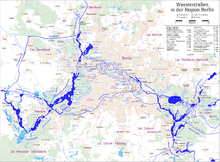Teltow Canal
The Teltow Canal, also known as the ![]()
| Teltow Canal | |
|---|---|
The canal near Kleinmachnow lock | |
| Specifications | |
| Length | 37.83 km (23.51 miles) |
| Minimum boat draft | 1.75 metres (5.7 ft) |
| Minimum boat air draft | 4.4 metres (14 ft) |
| History | |
| Construction began | 1900 |
| Date completed | 1906 |
| Geography | |
| Start point | River Havel |
| End point | River Dahme |

The canal is 37.83 kilometres (23.51 mi) in length and links the River Havel near the city of Potsdam with the River Dahme near Köpenick in Berlin's eastern suburbs. The Dahme provides a link to the Oder-Spree Canal, and hence to the River Oder and Poland. Whilst the Dahme is a tributary of the River Spree, itself a navigable tributary of the Havel, the Teltow Canal offers the advantage of bypassing the centre of Berlin, with its heavy river traffic.[1]
At its western end, the Teltow Canal incorporates the Griebnitzsee lake which links to the Havel in Potsdam. The Griebnitz Canal provides a second link to the Havel from the eastern end of the Griebnitzsee. Towards its eastern end, the Teltow Canal is linked to the Landwehr Canal by the Neukölln Ship Canal, while the Britz Canal connects the Teltow Canal with the Spree.[1]
There is only one lock on the canal, at Kleinmachnow. The canal is navigable by boats with a draught of up to 1.75 metres (5 ft 9 in) and with a maximum bridge clearance of 4.4 metres (14 ft).[1]
References
- Sheffield, Barry (1995). Inland Waterways of Germany. St Ives: Imray Laurie Norie & Wilson. p. 118. ISBN 0-85288-283-1.
- Köhler, Horst (May 2000). "Der Teltowkanal - Vom Wunsch zur Idee". Berlinische Monatsschrift (in German). Luisenstädtischer Bildungsverein.